Overview
- Description
- Wartime and immediate post-war documents illustrating Ivan/Johann's experiences in Buchenwald and post-war allied Europe.
- Credit Line
- United States Holocaust Memorial Museum Collection, Gift of Lorraine DeMaio
Physical Details
- Language
- German English Serbo-Croatian Italian
- Extent
-
1 folder
Rights & Restrictions
- Conditions on Access
- There are no known restrictions on access to this material.
- Conditions on Use
- The Museum is in the process of determining the possible use restrictions that may apply to material(s) in this collection.
Administrative Notes
- Holder of Originals
-
United States Holocaust Memorial Museum
- Legal Status
- Permanent Collection
- Provenance
- Acquired by Ivan (Johann) Bolé (donor's father) during World War II. Donated to the United States Holocaust Memorial Museum in 2011 by Lorraine DeMaio.
- Record last modified:
- 2024-04-01 11:41:15
- This page:
- https://collections.ushmm.org/search/catalog/irn44088
Download & Licensing
- Copyright Not Evaluated
- Terms of Use
- This record is not digitized and cannot be downloaded online.
In-Person Research
- Request 7 Days in Advance of Visit
- Plan a Research Visit
-
Request in Shapell Center Reading Room
Bowie, MD
Contact Us
Also in John Bolé collection
The collection consists of four drawings, a cap, a pouch, a finger ring, and documents relating to the experiences of John Bolé (born Ivan Bolé) during the Holocaust in Buchenwald concentration camp, and after the Holocaust in displaced persons camps in Italy and Germany.
Date: 1942-1950
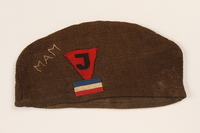
Brown hat with a triangular patch bearing a J and initials worn by John Bolé
Object
Brown cap with two patches worn by John (born Ivan Johann) Bolé, 29, in Buchenwald concentration camp from November 1944 until April 1945. The J (for Jugoslawisch) and the red inverted triangle indicated the wearer was a Yugoslavian political prisoner. The striped patch represents the Yugoslavian flag. John, a Catholic, was a lawyer in Laibach, Yugoslavia (Ljubljana, Slovenia) when the Axis powers, led by Nazi Germany, invaded in April 1941. Laibach was annexed by Italy. John went to Venice with the Slovenian Red Cross. In September 1944, he was arrested by the German SS for smuggling a radio transmitter into Trieste. In November, John was sent to Buchenwald in Germany and assigned prisoner number 67186. He was assigned to work commando A6 in Wanz-leben am See. The camp was liberated on April 11, 1945, by US troops. Germany surrendered on May 7. John lived as a displaced person in Garmisch-Partenkirchen, Germany, and immigrated to America in 1950.
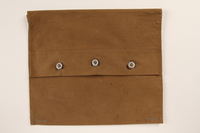
Button-flap, cloth pouch used by John Bolé
Object
Military style, brown, cloth pouch used by John (born Ivan Johann) Bolé, 29, in Buchenwald concentration camp where he was held as a Yugoslavian political prisoner from November 1944 until April 1945. John, a Catholic, was a lawyer in Laibach, Yugoslavia (Ljubljana, Slovenia) when the Axis powers, led by Nazi Germany, invaded in April 1941. Laibach was annexed by Italy. John went to Venice with the Slovenian Red Cross. In September 1944, he was arrested by the German SS for smuggling a radio transmitter into Trieste. In November, John was sent to Buchenwald in Germany and assigned prisoner number 67186. He was assigned to work commando A6 in Wanz-leben am See. The camp was liberated on April 11, 1945, by US troops. Germany surrendered on May 7. John lived as a displaced person in Garmisch-Partenkirchen, Germany, and immigrated to America in 1950.
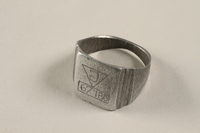
Aluminum ring with a letter and prisoner number owned by John Bolé
Object
Engraved, aluminum ring that belonged to John (born Ivan Johann) Bolé, who was imprisoned in Buchenwald concentration camp from November 1944 - April 1945. It is engraved with a J (Jugoslawisch) and an inverted triangle, the symbols Ivan was labelled with to identify him as a Yugoslavian political prisoner. John, a Catholic, was a lawyer in Laibach, Yugoslavia (Ljubljana, Slovenia) when the Axis powers, led by Nazi Germany, invaded in April 1941. Laibach was annexed by Italy. John went to Venice with the Slovenian Red Cross. In September 1944, he was arrested by the German SS for smuggling a radio transmitter into Trieste. In November, John was sent to Buchenwald in Germany and assigned prisoner number 67186. He was assigned to work commando A6 in Wanz-leben am See. The camp was liberated on April 11, 1945, by US troops. Germany surrendered on May 7. John lived as a displaced person in Garmisch-Partenkirchen, Germany, and immigrated to America in 1950.
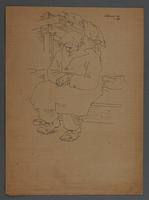
Drawing of a seated inmate in an overcoat by Nikolaj Pirnat acquired by John Bolé
Object
Double-sided portrait of a concentration camp prisoner by Nikolaj Pirnat acquired by John (previously Ivan Johann) Bolé. Pirnat was a Slovenian artist imprisoned at Gonars concentration camp in Italy from 1942-1943. John was imprisoned as a Yugoslavian political prisoner at Buchenwald concentration camp in Germany, from November 1944 to April 1945. It is unclear when or how he acquired the drawings. John, a Catholic, was a lawyer in Laibach, Yugoslavia (Ljubljana, Slovenia) when the Axis powers, led by Nazi Germany, invaded in April 1941. Laibach was annexed by Italy. John went to Venice with the Slovenian Red Cross. In September 1944, he was arrested by the German SS for smuggling a radio transmitter into Trieste. In November, John was sent to Buchenwald in Germany and assigned prisoner number 67186. He was assigned to work commando A6 in Wanz-leben am See. The camp was liberated on April 11, 1945, by US troops. Germany surrendered on May 7. John lived as a displaced person in Garmisch-Partenkirchen, Germany, and immigrated to America in 1950.
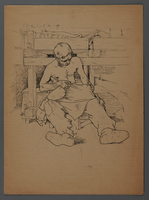
Drawing of an inmate repairing a shirt by Nikolaj Pirnat and acquired by John Bolé
Object
Double-sided portrait of a concentration camp prisoner by Nikolaj Pirnat acquired by John (previously Ivan Johann) Bolé. Pirnat was a Slovenian artist imprisoned at Gonars concentration camp in Italy from 1942-1943. John was imprisoned as a Yugoslavian political prisoner at Buchenwald concentration camp in Germany, from November 1944 to April 1945. It is unclear when or how he acquired the drawings. John, a Catholic, was a lawyer in Laibach, Yugoslavia (Ljubljana, Slovenia) when the Axis powers, led by Nazi Germany, invaded in April 1941. Laibach was annexed by Italy. John went to Venice with the Slovenian Red Cross. In September 1944, he was arrested by the German SS for smuggling a radio transmitter into Trieste. In November, John was sent to Buchenwald in Germany and assigned prisoner number 67186. He was assigned to work commando A6 in Wanz-leben am See. The camp was liberated on April 11, 1945, by US troops. Germany surrendered on May 7. John lived as a displaced person in Garmisch-Partenkirchen, Germany, and immigrated to America in 1950.
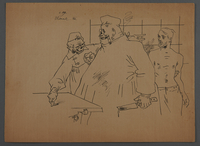
Drawing of two skeletal doctors with an imprisoned patient by Nikolaj Pirnat and acquired by John Bolé
Object
Drawing of two caricatured doctors and a concentration camp prisoner by Nikolaj Pirnat acquired by John (previously Ivan Johann) Bolé. Pirnat was a Slovenian artist imprisoned at Gonars concentration camp in Italy from 1942-1943. John was imprisoned as a Yugoslavian political prisoner at Buchenwald concentration camp in Germany, from November 1944 to April 1945. It is unclear when or how he acquired the drawings. John, a Catholic, was a lawyer in Laibach, Yugoslavia (Ljubljana, Slovenia) when the Axis powers, led by Nazi Germany, invaded in April 1941. Laibach was annexed by Italy. John went to Venice with the Slovenian Red Cross. In September 1944, he was arrested by the German SS for smuggling a radio transmitter into Trieste. In November, John was sent to Buchenwald in Germany and assigned prisoner number 67186. He was assigned to work commando A6 in Wanz-leben am See. The camp was liberated on April 11, 1945, by US troops. Germany surrendered on May 7. John lived as a displaced person in Garmisch-Partenkirchen, Germany, and immigrated to America in 1950.
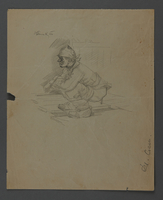
Drawing of a prisoner using a latrine by Nikolaj Pirnat and acquired by John Bolé
Object
Portrait of a prisoner defecating in a concentration camp latrine by Nikolaj Pirnat acquired by John (previously Ivan Johann) Bolé. Pirnat was a Slovenian artist imprisoned at Gonars concentration camp in Italy from 1942-1943. John was imprisoned as a Yugoslavian political prisoner at Buchenwald concentration camp in Germany, from November 1944 to April 1945. It is unclear when or how he acquired the drawings. John, a Catholic, was a lawyer in Laibach, Yugoslavia (Ljubljana, Slovenia) when the Axis powers, led by Nazi Germany, invaded in April 1941. Laibach was annexed by Italy. John went to Venice with the Slovenian Red Cross. In September 1944, he was arrested by the German SS for smuggling a radio transmitter into Trieste. In November, John was sent to Buchenwald in Germany and assigned prisoner number 67186. He was assigned to work commando A6 in Wanz-leben am See. The camp was liberated on April 11, 1945, by US troops. Germany surrendered on May 7. John lived as a displaced person in Garmisch-Partenkirchen, Germany, and immigrated to America in 1950.



